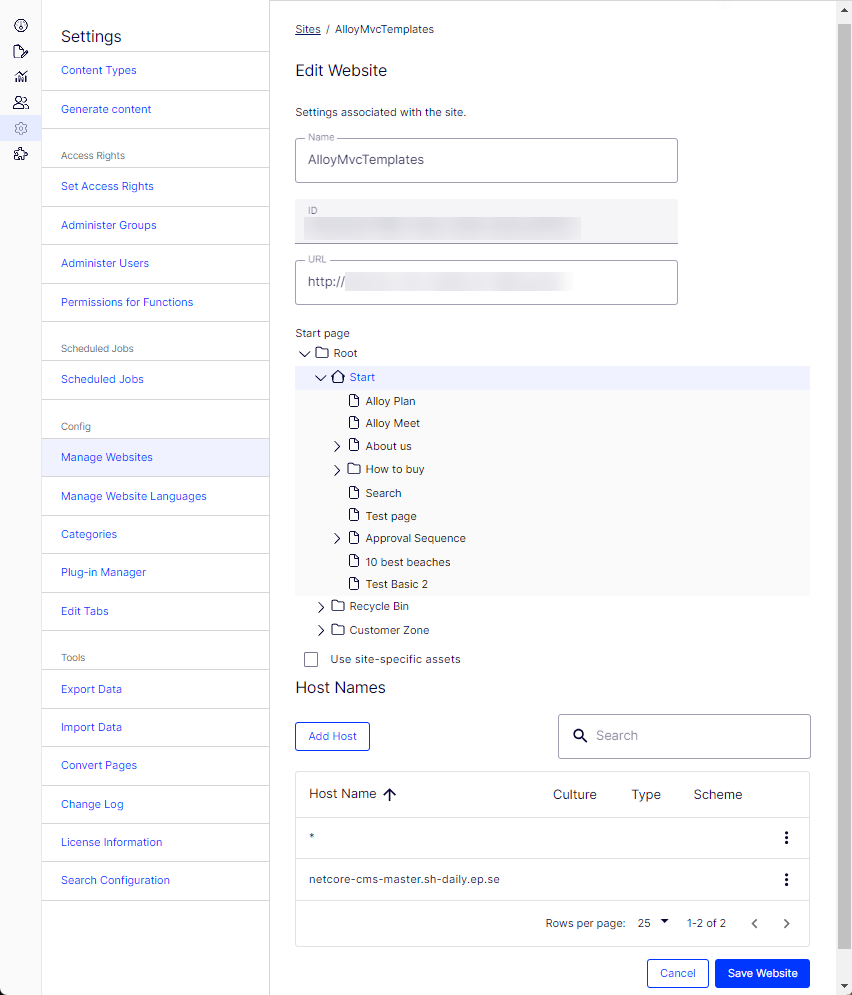Initial configuration
Describes some typical initial configurations you need to consider when setting up a CMS solution.
NoteIf your organization migrated to Opti ID, you must manage users in Opti ID. See the Opti ID user documentation.
You can configure the Optimizely Content Management System (CMS) in multiple locations, depending on the type of settings. Typical examples are configuration files such as appSettings.json, environment variables, content types, and templates in code and site configuration in the database.
You should have installed an empty CMS site and added a page type, as described in Create a starter project.
Configuration
An ASP.NET Core web application can have several different sources for configuration data, such as an appSettings.json configuration file or environment variables. See Configuration for more details about default configuration settings when you install CMS.
Content types
Content types and templates are typically defined in code and stored in the database. Each content type consists of several properties, such as Title (MetaTitle) and Main body (MainBody). Available content types are displayed in the admin view, and you can modify their properties from here.
NoteYou can create content types from the admin view (see Content types in the CMS user guide), but creating page types from code makes pages more strongly typed.
For example, administrators can change the tab under which a property is displayed or the order in which properties are displayed for a content type.

During website initialization, the synchronization engine in CMS scans and validates available content types and properties created in code or from the CMS admin view. See Content model and views.
Database configuration
An important configuration setting is the connection string, which must contain the path to your server and database, and SQL login and password. By default, CMS uses the connection string named EPiServerDB_._DataAccessOptions to configure a different named connection string.
"ConnectionStrings": {
"EPiServerDB": "Server=.;Database=EPiServerDB_7607b9ba;User Id=EPiServerDB_7607b9baUser;Password=BEo7Q2jzmX$kv$e"
}You configure the site URL and start page in the admin view and store it in the database. This makes deployment easier, and you can add and remove sites dynamically without restarting the application.
Configure the start page
When you build a website from scratch, you will first create a set of content types and content items. To go to your site, define a site URL and start page, which acts as a default URL to the site when links are generated.
The start page is often a specific page type with unique properties, but you can configure any page type as a start page in the Settings view under Config > Manage Websites, by selecting a page in the page tree. The SiteUrl, StartPage, and host mapping settings are stored in the database.

See Create a starter project and Set up multiple sites.
Authentication and authorization
The default authentication in Optimizely CMS is based on the ASP.NET Core built-in framework for authentication and authorization. When implementing an Optimizely solution, you can choose which authentication to use.
Configure authentication
ASP.NET Core Identity authentication
You can configure your website to use ASP.NET Core Identity as authentication for managing users and roles. There is package EPiServer.Cms.UI.AspNetIdentity is a CMS-specific implementation based on ASP NET Core Identity. See AspNetIdentity.
NoteThe Optimizely sample site (Alloy templates) uses ASP.NET Core Identity for authentication.
Entra ID integration
If you are developing a website for the cloud, you may want to use Entra ID (formerly Azure AD) for directory and identity management. Optimizely provides the possibility to use OpenID Connect to integrate with Entra ID. See Integrate Entra ID using OpenID Connect.
Configure access rights
Optimizely uses an extension of the Role concept called virtual roles. These roles are not original role claims for the user but dynamically added claims where the membership criteria are determined at runtime. VirtualRoleOptions control virtual roles.
These virtual roles are delivered with Optimizely:
- Administrators
- Everyone – Provides visitor access to front-end
- Authenticated
- Anonymous
- CmsAdmins – Mapped role, maps to WebAdmins, Administrators
- CmsEditors – Mapped role, maps to WebEditors
- Creator
- SearchAdmins – Mapped role, maps to WebAdmins, Administrators
You can also create your virtual roles in code and register them through VirtualRoleOptions. See Virtual roles.
WebAdmins and WebEditors are non-virtual Optimizely-specific groups. They provide access to the CMS admin and edit views. The groups are predefined in Optimizely, but they must be added from the admin view to become available for usage if you manage users in the CMS admin view, using EPiServer.Cms.UI.AspNetIdentity package.
When configuring your authentication and adding users to appropriate groups, you must define what users can do where in the content structure. See Access rights in the Optimizely User Guide.
Logging
When setting up a website, configure logging, such as troubleshooting. You can use different logging tools. Logging within CMS is based on the logging framework within ASP.NET Core, so configuring logging for a CMS application is the same as for other ASP.NET Core applications. See Logging.
Updated about 1 month ago